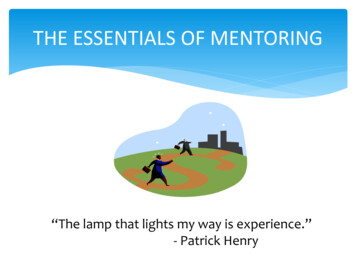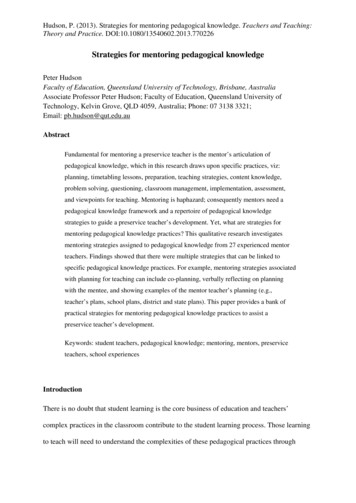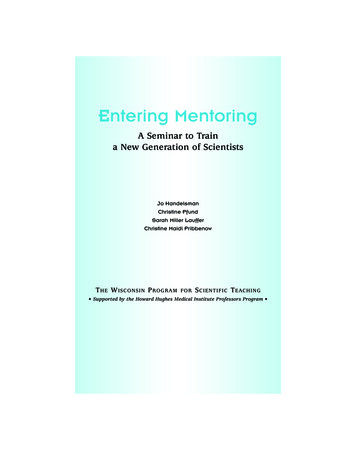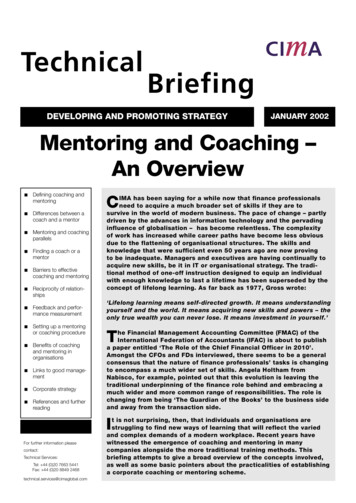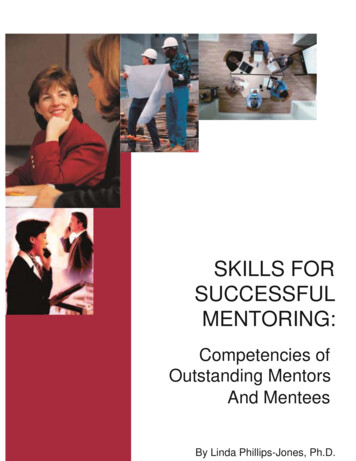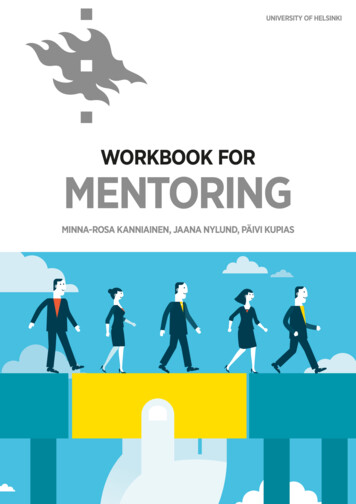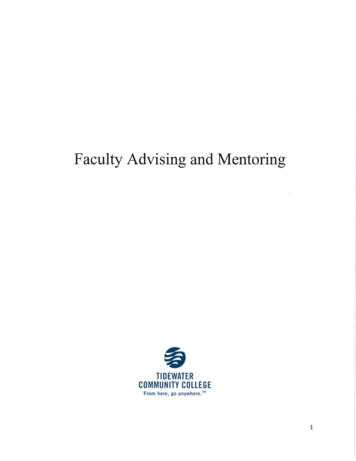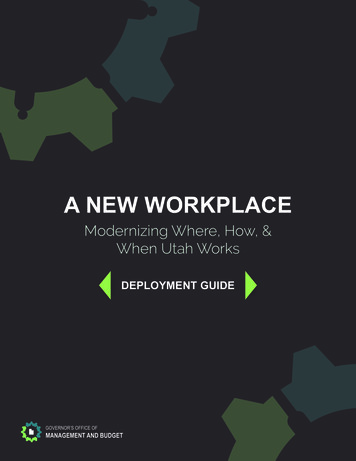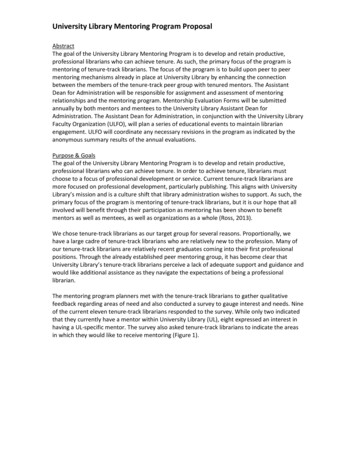
Transcription
WORKPLACEMENTORINGSUPPLEMENT TO THEELEMENTS OF EFFECTIVEPRACTICE FOR MENTORINGOctober 2019
TABLE OF CONTENTSIntroduction and the World of Workplace Mentoring. 3Standard 1: Recruitment.20Standard 2: Screening. 40Standard 3: Training. 52Standard 4: Matching and Initiation.70Standard 5: Monitoring and Support. 82Standard 6: Closure.91Program Planning, Management, and Evaluation. 103AUTHORS AND CONTRIBUTORS:Dr. Janis Kupersmidt; innovation Research & Training, Dr. Rebecca Stelter; innovation Research & TrainingMichael Garringer; MENTOR: The National Mentoring Partnership, Justin Mayhew; innovation Research & TrainingSPONSORED BY:ACKNOWLEDGEMENTS:MENTOR and iRT would like to thank the following institutions and organizations for their supportof this resource:-J PMorgan Chase for their generous support of this resource and for the high-quality mentoring relationshipsoffered through The Fellowship Initiative, which serves as an exemplar of workplace mentoring for youngpeople and was an initial inspiration for this project.-T he members of the working group of expert practitioners and researchers who helped shape therecommendations found in these pages (see page 14 for more information about this group).-T hanks to Erin Souza-Rezendes and Janicanne Shane for their editing at MENTOR.-S pecial thanks to Cecilia Molinari and Jenni Geiser for their support in copyediting andgraphic design, respectively.WORKPLACE MENTORING SUPPLEMENT2
INTRODUCTION AND THE WORLD OF WORKPLACE MENTORINGOne of the dominant trends of theyouth mentoring movement overthe last decade is the proliferationof mentoring roles into settingsthat go far beyond either dedicatedmentoring programs (e.g., BigBrothers Big Sisters) or typicalyouth development contexts (e.g.,after-school programs). A 2015 survey oforganizations that provide youth mentoring servicesfound that the vast majority of them also run someother service or intervention for youth or families.1While it is unclear how frequently the mentoringprogram within these organizations supported theother services and interventions, one can assumethat in many of these organizations, dedicatedmentoring was provided in conjunction withother services and supports, bringing mentors toeverything from clinical mental health interventionsto college and career preparatory services.In fact, this same survey found that 26 percent ofthe agencies that run mentoring programs alsooffer separate workforce development and jobtraining services. And when asked specifically abouttheir goals and areas of emphasis for youth whoreceive mentoring, a quarter of mentoring programsindicated that they focus on career exploration,with an additional 6 percent focusing specifically onScience, Technology, Engineering, and Math (STEM)education and career pathways. Broadly speaking,career exploration and engagement is the thirdmost common goal across mentoring programs inthe United States.2WORKPLACE MENTORING SUPPLEMENTThe application of mentoring relationships in serviceof career goals, especially for new or entry-levelworkers, is nothing new. In fact, we can trace thevalue of deep learning relationships with moreexperienced adult professionals back to the guildand apprentice structures that emerged literallyseveral centuries ago. In more recent times, it hasbecome fashionable for companies to offer internalmentoring opportunities to their adult employeesas a way of encouraging employee retention,sharing institutional knowledge, and supportingthe advancement of lower-level workers intosupervisory positions and management over time.But several recent trends have also converged toignite renewed interest in using mentors to supportolder adolescents and young adults as they enterthe world of work:o A growing emphasis on equity within certainfields. There has been major investment inSTEM mentoring programs for youth in an effortto bring more women, minorities, and peoplewith disabilities into STEM careers where theyare severely underrepresented. In fact, see ourcompanion publication, the STEM Supplement tothe Elements of Effective Practice for Mentoring,to read about how leading tech companies suchas Genentech and 3M, and programs like Girls Inc.and Science Club, are using mentoring to addresssystemic inequities in those fields.3 For a greatexample of a program that is working to makethe world of work (both STEM and otherwise)more accessible for youth with disabilities, see thedescription of the Disability:IN program later inthis chapter.3
INTRODUCTION AND THE WORLD OF WORKPLACE MENTORINGo A general desire to strengthen talent pipelines.Many American industries (e.g., manufacturing4and the aforementioned STEM fields5) aresuffering from a shortage of qualified workers ofall types and mentoring can be a way to initiallyinterest youth in pursuing particular careers,as well as keeping them on that pathway asthey overcome hurdles and build their sense ofbelonging within an industry.o Efforts to integrate “opportunity” youth intothe labor market. Much has been made in recentyears about so-called “opportunity youth,” youngpeople ages 16–24 who are not working, enrolledin school, or engaged in other prosocial activitiesand institutions. The services provided to theseyoung people require taxpayer investment, andthey are not contributing to the economy morebroadly.6 To the nation’s credit, there has beenmuch effort over the last decade to reengage thispopulation. Relationships with adults are often atthe heart of efforts to get opportunity youth backinto the worlds of education and work.7These trends, along with recognition that it is hardertoday for young workers to find entry-level jobs andslowly build a resume and relevant job experiencethan in prior generations, have led to an explosion inthe number of youth mentoring programs that areexplicitly helping youth explore careers.Today we find a diverse landscape of career andworkplace mentoring options for youth, one thatcovers everything from mentoring programs formiddle schoolers to introduce them to careers theymay never have considered, to hybrid job shadow/mentoring programs that bring young adults intoworksites to build both hard and soft skills thatwill benefit them for the long haul (and perhapseven land them a job in the short term with thatcompany).What are the practices that make these mentoringprograms effective? What are the day-to-daypractices that these types of programs employthat differ from more traditional “developmental”mentoring programs? While there are someDefining Workplace Mentoring for YouthWhile there are many ways that mentors can support youth of all ages as they learn about, explore, andengage in career pathways, this guide’s recommendations will be most applicable to programs: Serving older adolescents and young adults (16–24). C onnecting employees of a business or a particular industry to serve as mentors to youth who areconsidering a career in that industry or related field. B ringing, at least occasionally, mentees to job sites and workplace environments for hands-onlearning and shadowing. O ffering both job-related skill development and socioemotional support to ease the transition intothe role of a worker.While these actions may not describe many mentoring programs focused on career interests, they dorepresent the most common features of programs we observed utilizing mentoring to support careerinterests and placements for youth and young adults.WORKPLACE MENTORING SUPPLEMENT4
INTRODUCTION AND THE WORLD OF WORKPLACE MENTORINGsimilarities of good practice across all youthmentoring programs, these workforce-focusedprograms often have complex partnershipsbetween nonprofits, schools, local employers, andother entities, as well as different expectationsfor mentors and the youth themselves. So whatmakes this new generation of workplace mentoringprograms tick?Answering these questions is the purpose of thisguide, as we examine the practices of successfulworkplace mentoring programs for youth andoffer specific recommendations for running such aprogram beyond those found in the overall Elementsof Effective Practice for Mentoring. Throughout therest of this resource you can find recommendationsand case studies that can help similar programsprepare the mentors who will in turn prepare youthfor the world of work.THE WORLD OF WORKFORCE-FOCUSEDMENTORING PROGRAMSTo better understand the landscape of workplacementoring programs for youth, the team of authorsbehind this resource conducted a literature searchfor scholarly articles, evaluation reports, trainingcurricula, and other materials relevant to mentoringprograms with a career exploration or job skillscomponent. We utilized prominent databases—primarily Scopus, PubMed, Google Scholar, andERIC—then expanded to include additional articlessuggested in the references of documents found inthe initial search. When possible, relevant chaptersfrom books and essay collections were alsoincluded.In all, we reviewed 198 separate articles, books, bookchapters, reports, and other programmatic materialsin developing this supplement. The following tableoffers a breakdown of these resources:WORKPLACE MENTORING SUPPLEMENTn1 09 were articles published in peerreviewed journals.n 58 featured results of formal programevaluations (including qualitative evaluationsor non-experimental research detailingparticipant experiences, as well as metaanalytic summaries of research on formalprograms).n 11 focused on programs or mentoringexperiences serving elementary or middleschool ages, 43 focused on high schoolages, and 74 focused on either young adults(post-high-school graduation) or on adultworkplace mentoring.n 4 featured examinations of natural mentors3in workplace and academic settings, ratherthan mentors supplied through a formalprogram. A small handful addressed both.While we did draw some themes andrecommendations from the literature on adultadult mentoring in the workplace, we emphasizedthe findings of programs focused on adolescentsor young adults just entering the workforce. Whenlooking at those programs, the vast majoritydescribed either brought professionals in aparticular industry or field to a school or nonprofitservice provider’s facilities in order to mentoryouth and discuss careers and skills related to theirindustry or, more often, brought youth to worksitesfor hands-on learning, skill building, and mentoringwithin the direct context of work.Several of the studies reviewed focused on, or atleast included, employee-employee mentoringwithin companies. While these programs technicallyexist outside of the preferred scope of this resource,5
INTRODUCTION AND THE WORLD OF WORKPLACE MENTORINGwe found value in examining their practices,particularly in how those programs were managedand how the mentoring experience was framed forboth junior and senior employees.In looking across all of this literature, several themesemerged.particularly helpful with the transition into workfor youth with disabilities, with studies notingsignificant improvements for these youth in careerrelated planning and preparation, knowledge ofcareer options and transitions, and social skills andpeer/coworker relations.10Looking broadly at the literature on workplacementoring, we see strong evidence that mentoredindividuals benefit in a number of ways comparedto workers who are not mentored. Perhaps themost global evidence for the impact of mentoringon careers are the meta-analyses led by Drs. LillianEby and Tammy Allen, which found that mentoredemployees often reported benefits related tocompensation, promotion, fringe benefits, jobsatisfaction, commitment and intent to stay in ajob, and overall career satisfaction and identity.8It is worth noting that some of the researchinforming these results included mentoring for adultemployees, but the roles and functions of mentorsdescribed in these studies—a blend of hands-on jobskill teaching and psychosocial support—mirrors therole of mentors working with youth and other entrylevel employees.Additional research has looked specifically at thevalue of mentors for high school–age studentsengaging in their first jobs. One study of workplacementoring programs found that mentors for youngapprentices in several trades were essential inhelping youth apply concepts they had learned inschool to real-world job settings, offering a safeenvironment for them to start applying knowledge,knowing that a more experienced professional wasalso there to assist them.11 This study also foundthat workplace programs offered skill developmentthat went beyond the technical skills of a job task—these additional “soft” skills included things suchas managing client relations, customer service, andworkplace communication. In another study, youthwho were working in their first jobs at companiesthat had a formal mentoring component were morelikely to see that school was relevant to the worldof work, had higher self-esteem, and enjoyed theirwork experiences more than youth working withoutthe benefit of workplace mentors. This studyconcluded that youth working without a mentorfound this early job experience to be “demoralizing”and in many ways harmed their perceptions aboutwork and themselves.12Other research notes that supportive mentors cansupplement the school-to-work transition and helpintegrate new employees into a workplace while alsohelping them identify with the role of “worker”—something that can be unfamiliar to young peoplejust entering the world of work.9 Mentors can beInterestingly, this study was one of many to findthat informal workplace mentors can be just aseffective in supporting young workers as thoseprovided by a formal program.13, 14 Both formal andinformal mentors in workplace programs seemto be effective at improving workplace attitudes,MAJOR THEMES FROM THE RESEARCHThere is compelling evidence thatmentoring relationships can be beneficialto youth and young adults as they enterthe workforce.WORKPLACE MENTORING SUPPLEMENT6
INTRODUCTION AND THE WORLD OF WORKPLACE MENTORINGmotivations, and relationships.15 But because not allyouth are equally adept at finding “natural” mentorsin workplace environments, formal programs canensure that all youth engaged in the transition intowork get the support they need.We have strong evidence that mentors can helpyoung people build their identities as workers, helpthem apply their school learning to work, teachthem soft skills that can be essential to careersuccess, improve their attitudes and motivationsabout work, and generally give young workersopportunities to learn new skills and how to bepart of a team. This sets the stage for ongoingcareer success and tangible rewards, such as highercompensation, advancement up career ladders, andgreater job stability.Workforce mentoring programs ofteninvolve complex program structures andcross-organization partnerships.Compared to most mentoring programs, whichare often provided by a nonprofit, a school,or some combination thereof, we found manydiverse partnership structures and collaborativemodels across the literature we examined. Wefound examples of programs run by a vocationalplacement center in partnership with multiplehigh schools and several local businesses,16 a highschool internship program that connected youthto worksites but also offered other courses andlearning opportunities through the nonprofit that ledthe program,17 a school-led program that connectedyoung people to employers who offered mentoringbut also offered academic credit for participation,18and a partnership between local businesses and ahigh school where youth spent one day a week atthe job site engaged in work-based learning for allfour years of their matriculation, to name a few. OneWORKPLACE MENTORING SUPPLEMENTprominent meta-analysis examined programs set inclassrooms (where employee mentors worked withgroups of students on projects), in the community(where mentors were free to help youth exploremany different careers, among other goals), and theworkplace (where mentees served as entry-levelemployees, even if they were technically part of anonprofit or school service that connected themto the job site).19 Given this diversity of programstructures, and the need to coordinate servicesand schedules across many locations, we place agreater emphasis on logistical considerations andclear roles and responsibilities for partners in therecommendations throughout the sections thatfollow.Program goals and areas of emphasis shiftwith the age and career developmentstage of the mentees.Programs serving younger adolescents tend tofocus on building initial excitement and enthusiasmfor careers in various fields, often letting menteesexplore many different career roles or fields. Asyouth age, programs become more focused,offering deeper learning experiences and handson application of skills to youth who want to trulyexperience what being in a job might be like. Atthe farthest end of the development spectrum areprograms for entry-level workers who are beingoriented to the workplace with the help of a mentor.Generally, programs for younger mentees are aboutbuilding workplace skills and competencies, aswell broadening the horizons of possible careers.The hands-on teaching of skills and embeddedexperiences at worksites then increase over timeas youth age and become eligible for real-workexperiences (see the sidebar for examples of suchexperiences).7
INTRODUCTION AND THE WORLD OF WORKPLACE MENTORINGMentors in workplace mentoring programsoften wear many hats.Perhaps the most striking finding from ourreview of the literature was the varied roles andresponsibilities that workplace mentors often take informal programs. While all mentors bring a varietyof skills and actions to bear on their relationships,mentors in workplace mentoring programs oftenhave to toggle between many different roles, someof which may be contradictory of each other.20 Forexample, it is not uncommon in these programs formentors to also be the supervisors of the mentees,meaning that they have to both provide friendshipand support while also being responsible for givingdirect feedback and work critiques. Several studiesdiscussed the tension between the obligationsto support the mentee and the obligations to thecompany to run a safe, productive team. Tryingto maintain a friendly, supportive mentoringrelationship while also balancing other workobligations is not easy.21, 22One prominent meta-analysis of workplacementoring identified several core mentoringbehaviors that workplace mentors frequentlyengaged in: sponsorship (arranging for menteeinvolvement in special projects), exposure andvisibility (touting the mentee to higher ups inthe company), coaching (direct teaching of skillsand giving advice), and protection (shielding thementee from harmful decisions or blame).23 Anotherprominent researcher, Stephen Hamilton, notedseveral distinct behaviors that workplace mentorsengage in: (a) instruct a learner on how to performa task, (b) demonstrate how a task is performed,(c) coach a learner as the task is being performed,(d) explain why a task is done in a particular way,(e) challenge a learner to perform well, (f) initiate aWORKPLACE MENTORING SUPPLEMENTCommon Contexts for Career-FocusedMentoringCareer explorationLearning about specific industries and jobs tofind an initial “spark”; most often housed inschools.Work-based learningTeaching skills, often around a collaborativeproject with students; often a combination ofclassroom and worksite activities.Job shadowsBrings youth into the workplace where they canobserve, build skills, “try on” the role; can rangefrom just a few visits to multiweek engagements(or longer).Internships/ApprenticeshipsYouth as quasi-employee, focused on skilldevelopment; generally lasting from onesemester to a full year at the job site.New employee onboardingYouth is an employee and the emphasis ison deepening engagement, solidifying roleidentity, and integration into workplace culture;often offered during “probationary” periods ofemployment or longer.Academic mentoringHappens in postsecondary setting with theintention to build workforce skills and masteryof content knowledge; often offered throughshadows or internships over the course of asemester or year of study.learner into the culture of a work organization, and(g) affirm a learner’s value as a person and talent asa worker.24 This list was later expanded by Hamiltonto include tasks such as critiquing the mentee’s8
INTRODUCTION AND THE WORLD OF WORKPLACE MENTORINGperformance, modeling problem solving, resolvingproblems in the workplace, and advising on furthercareer options.Another summary of the research on workplacementoring focused on the knowledge, skills, andattitudes that these mentors need to be successful.26Among the traits that literature suggests workplacementors need to possess or develop are:n Empathyn Ability to model work styles and behaviorsn Confidencen Patiencen Trustn Being good listeners and questionersn Technical knowledge of job and fieldn Strong past performance in the jobn Strong motivation to mentorn Role-modeling skillsn Credibility as a messengern Adequate time during workday to engage inmentoring activities and teachingAnd this list doesn’t even include other critical skillsand roles, such as the ability to give constructivefeedback, setting and honoring boundaries, helpingmentees set and plan for goals, and managinggroup dynamics when integrating a mentee into acollaborative team.27 While all of the frameworksand lists of competencies in the literature are helpfulwhen thinking about the mentoring role within aparticular program, most workforce mentoringprograms ask mentors to provide two explicitthings: 1) psychosocial support that helps with theattitudes, motivations, and interpersonal relationsWORKPLACE MENTORING SUPPLEMENTand skills of the mentee; and 2) career supportthat either teaches skills or helps the menteeapply classroom knowledge and helps them feelsuccessful in their job and produce good workresults. Broadly speaking, the research suggests thatmentoring programs in work environments may bebetter positioned to offer psychosocial support, butthat they can be effective in both.There are several keys to success forworkplace mentoring programs for youth.Most of the recommendations for good practicesuggested in the literature can be found in theremaining sections of this guide. But there werea few findings from the literature that are worthnoting here:oF or shorter-term programs, (e.g., those lasting justa semester or less in the case of working with aschool class) research suggests an emphasis onwork skills and other hands-on learning might bemore impactful than the psychosocial supportthat workplace mentors can also provide.29 Thoserelationships take time to gel and are often mostbeneficial when integrating new workers into arole where they will be longer term. Programswith short time frames may have more impact byemphasizing job skills and letting mentees focuson tasks and hands-on learning.oF requency of interaction is an importantconsideration in workplace mentoring programs,particularly those that are shorter in duration.30More interaction points simply provide moreopportunities for knowledge to be shared and forthe pair to develop a closer bond. As noted above,psychosocial support and overall perceptions ofrelationship quality both deepen with time, but iflength of match will be inherently short, programs9
INTRODUCTION AND THE WORLD OF WORKPLACE MENTORINGshould still ensure that mentors and menteeshave plenty of discrete moments for interactionand engagement together. Unfortunately, someworkplace mentoring programs give menteesrepetitive, simple entry-level tasks that limit bothmentor-mentee interactions and opportunities tolearn.31 Compared to academic mentoring, whichmay emphasize longer-term actions like rolemodeling and identity development, workplacementoring really depends on frequency ofinteractions to let mentees feel supported arounddoing the work, while also laying the foundationfor more personal forms of support.oT here were several discussions about goodmatching practices in the literature we reviewed.Most studies suggested that matching based onexperiential similarity (mentor-mentee similarityin terms of background, education level, currentjob tasks, longer-term career goals, etc.) wasbeneficial.32, 33 There seems to be some consensusthat mentees should be paired with mentorswho are above them in terms of position andmastery of skills, but who are still within the samedepartment or job type.34 Matching mentees tomentors who are similar but further along in theircareer path accomplishes several things:o It allows mentors to apply what they knowbest to what the mentee is learning. Theyget to share all the “tricks of the trade” witha junior colleague who is eager to learn andcan emphasize both job skills and job-specificpsychosocial support. Simply put, the mentoris in a more comfortable situation to teach.o It also allows for better role modeling. Amentee might be able to picture their futureself more effectively in a more advanced peerin a way that they might not if they wereWORKPLACE MENTORING SUPPLEMENTmatched with, say, a vice president of thecompany. Those mentors are so much higherup the career ladder that it can be hard fora mentee to see themselves in that role, andthe mentor likely has less direct knowledge toshare.o I t allows for easier integration of the menteeinto a “team.” While almost all the programswe reviewed featured one-to-one mentormentee pairs, the reality is that mentees oftenfind themselves joining a team of coworkers ina department or unit that does similar work.Being matched with an experienced leaderwithin that group helps ease the transitioninto the group environment and can leadto the establishment of additional informalmentoring relationships.While there are some advantages of pairingmentees with management positions and higher,especially in programs intended to motivatementees to go high up a career ladder, thechances are that they might find more commonground and more relevant forms of support froma mentor who is closer to where they are in theircareer.o It is worth noting, however, that there was someevidence in the research we reviewed in favorof what might be thought of as distributedmentoring, where a mentee gets mentoring froma variety of people, positions, and roles withina company or an industry.35 This approach canoffer mentees broader perspectives and canalleviate negative mentoring experiences wherethere is conflict with a primary mentoring figure.Even in programs that intentionally match oneto-one, there should be efforts to encourage thementee to find additional mentors beyond just10
INTRODUCTION AND THE WORLD OF WORKPLACE MENTORINGtheir primary one. When it comes to successfultransition into a workplace or supporting feelingsof belonging in an industry or field, it may be acase of “more is better.”oW e found several examples in the literatureof programs that provided more than just aplacement at a job site and a mentor to “show youthe ropes.” These types of programs offer whatcan be thought of as “pre-internship” or “preapprentice” experiences36 where program staff,usually from a nonprofit leading the program,provide a lot of the coaching and teachingaround professionalism and soft skills in an effortto make sure that the mentee is prepared forthe culture and ready to contribute when theyget to the job site.37 These models make a lotof sense as employee mentors are often nottrained in strategies for teaching soft skills or themore subtle nuances of professionalism. Theseprograms that spend time preparing menteesfor the world of work can often experiencefewer mentor-mentee conflicts and provide theirbusiness partners with youth who are ready tointegrate into the culture of the organization,or who possess critical skills, when they showup. (For one such example of a program thatWORKPLACE MENTORING SUPPLEMENTprepares youth for the mentoring experiencewhile augmenting it with additional teaching andskill development, see the brief case study on thework of Urban Alliance on this page.)Even in programs that don’t offer this preparatoryperiod for mentees, the literature suggest thatemployers should be prepared to help menteesdevelop their soft skills and learn what it is like to bea worker, to take on that identity and all it entails.38Employers should not expect that youth will showup with those skills inherently and may want to seekout program models where a school or nonprofitpartner is helping get youth ready to be in theworkplace environment.There are also models where employees get readyfor the world of work without focusing on beingembedded in the worksite at all. One prominentexample of this general skills approach can be foundin the side bar about the work of General Motors’sStudent Corps program, which engages youth andGM employees in intensive community projects thatare not strictly about entering the workplace butthat provide youth with a wealth of job-related skillsnonetheless.11
INTRODUCTION AND THE WORLD OF WORKPLA
MENTORING PROGRAMS To better understand the landscape of workplace mentoring programs for youth, the team of authors behind this resource conducted a literature search for scholarly articles, evaluation reports, training curricula, and other materials relevant to mentoring programs with a career exploration or job skills component.
